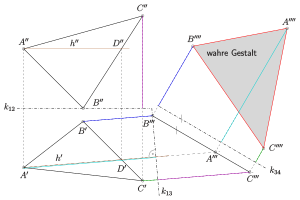True form
In descriptive geometry , planar figures are usually distorted by projections. The true shape method offers the possibility of rectifying flat figures, which are distorted in plan and elevation, by means of 2 re-projections (see two- panel projection ).
True shape of a triangle
The procedure is explained using the example of a triangle:
The triangle is given in plan and elevation. Find its true shape (length of the sides, size of the angles). The aid for solving the problem is to reproject the given cracks in such a way that a crack (vertical parallel projection) of the triangle is created in which the triangle is parallel to the new crack panel. How to introduce a new crack panel is described in the article two panel projection .
Implementation , if the new crack table is assigned to the floor plan:
- Determine a contour line of the triangle (see picture).
- The new crack plane is chosen so that is.
- Drawing in . They lie on a straight line because the choice of the crack edge means that the triangle plane is perpendicular to the new crack table .
- So that the triangle is parallel to the next crack plane , the new crack edge is selected parallel to the straight line through .
- The new crack shows the true shape of the triangle.
(Note: a) The distance from a point in a new crack (e.g. ) to the new crack edge ( ) is equal to the distance from the point in the crack that disappears ( ) to the crack edge ( ). b) A right angle appears undistorted in a crack if one leg is parallel to the crack plane.)
Example roof surface with a hexagonal hole
In this example, a hexagonal hole is to be cut in a (flat) roof surface so that a viewing tower can be built with a regular hexagonal cross-section. The carpenter needs a true-to-size drawing of the roof area with the hexagon in its true shape. The elevation of the hexagon is not required because the crack of the roof surface including the hexagon appear as lines in the crack plane . So it is sufficient to reproject the roof area and mark the hexagon on the crack of the roof area using folders. When re-projecting according to , the distances from the floor plan (omitted crack) are adopted.
Note that the true roof area is viewed from below.
If the true shape of an ellipse is to be determined, first of all use the above method to determine the true shape of a triangle consisting of a center point and 2 conjugate points (see conjugate diameters ) and then use the Rytz axis construction (see ellipse (representative geometry) ) to construct the Parting.
See also
True length (descriptive geometry)
literature
- Fucke, Kirch, Nickel: Descriptive Geometry. Fachbuch-Verlag, Leipzig 1998, ISBN 3-446-00778-4
- Cornelie Leopold : Geometric Basics of Architectural Representation. Verlag W. Kohlhammer, Stuttgart 2005, ISBN 3-17-018489-X
Web links
- Normal (orthogonal) axonometry with simple examples
- Descriptive geometry for architects (PDF; 1.5 MB). Script (Uni Darmstadt), p. 40












